Case Report - (2022) Volume 6, Issue 6
The Usefulness of Endoanal Endoscopic Ultrasound in Anal Disease
Maroua Saidi Idrissi*,
M Salihoun,
I Serraj,
M Acharki and
N Kabbaj
Department of Gastroenterology EFD-HGE, Ibn Sina University Hospital, Morocco
*Correspondence:
Maroua Saidi Idrissi, Department of Gastroenterology EFD-HGE, Ibn Sina University Hospital,
Morocco,
Received: 01-Jun-2022, Manuscript No. IPJCGH-22-13537;
Editor assigned: 03-Jun-2022, Pre QC No. IPJCGH-22-13537 (PQ);
Reviewed: 17-Jun-2022, QC No. IPJCGH-22-13537;
Revised: 22-Jun-2022, Manuscript No. IPJCGH-22-13537 (R);
Published:
29-Jun-2022, DOI: 10.36648/2575-7733.6.6.27
Abstract
Introduction: Anal disease encompasses various disorders including sphincter defects, anorectal fistulas and
abscesses, unexplained chronic anal pain, and anal cancers. The aim of this study is to evaluate the diagnostic contribution
of endoscopic ultrasound (EUS) in anal disease.
Materials and methods: 56 patients underwent radial EUS examination, from March 2015 to March 2022. No sedation
was needed for EUS examination. All EUS were performed using a flexible radial EUS probe with or without
a linear probe and an ultrasound processor.
Results: Mean age was 42, 4 years, 71.42% were female. The main clinical indication of anal EUS was the evaluation
of anorectal suppuration, fecal incontinence (FI) and perineal crohn disease (CD). Anorectal suppurations were
identified in 35.71% of cases. In patients with perineal CD, fistulas were found in 46.15% of CD cases. Anovaginal
or rectovaginal fistulas (ARVFs) unrelated to CD were visualized in 8.93% of all cases. In patients presenting with FI,
EUS identified internal and external anal sphincter defects.
Conclusion: EUS is a sensitive technique in the evaluation of anal anatomy and the diagnosis of benign and malignant
anal disease.
Keywords
Endoscopic ultrasound; Anal disease; Anal fistula; Rectovaginal fistula; Crohn disease
Introduction
EUS is a sensitive tool in the evaluation of proctologic pathologies;
it allows identification of sphincter defects, anoperineal
fistulas and abscesses, exploration of perineal CD and staging
of anorectal cancers. The results of anal EUS can greatly
influence the therapeutic management of various anorectal
disorders, making EUS an essential examination tool in the
pre-therapeutic assessment of various anoperineal conditions.
We report the clinical indications and results of endoanal EUS
conducted in 56 patients.
Case Presentation
A monocentric study included 56 patients with various proctological
symptoms, from January 2015 to March 2022. The
medical records of the patients were reviewed to conduct the
study. No sedation was needed for EUS examination.
No oral bowel preparation was required; patients were prepared using a cleansing enema 2 hours before the procedure.
All EUS were performed using a flexible radial EUS probe with
or without a linear probe (Pentax®) and an ultrasound processor
(Aloka-Hitachi®). All EUS examinations were performed by
experienced endoscopists. Rectal tumors were excluded from
our study. We excluded from the study poorly prepared patients
and patients who had a rectal tumour.
Results
The mean age was 42.4 years [range: 11-90 years]. The sex ratio
was M: F 0.4 (71.42% female. 28.57% male). The most common
proctological symptoms were FI and/or anal pain (Figure
1). The Mean age of patients presenting with FI was 50.45 years
(19-90 years), predominately females (Figure 2). 45.83% of patients
had a history of perianal surgery and among the women
27.27% were multiparous. EEA showed internal anal sphincter
(IAS) defect in 41.66% of cases, and external anal sphincter (EAS) defect in 20.83% (Figures 3 and 4).
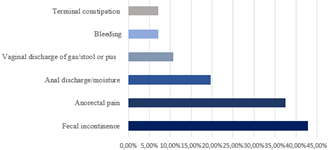
Figure 1: Clinical symptoms experienced by the patients in our study
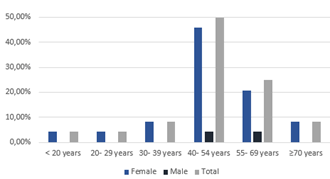
Figure 2: Overall frequency of FI by age and sex
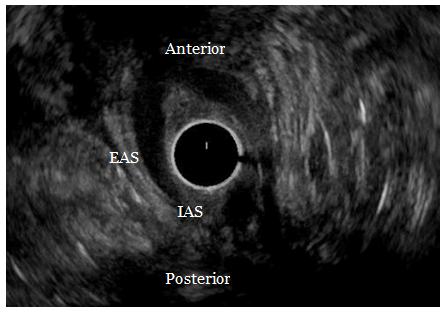
Figure 3: EES findings in cases of fecal incontinence
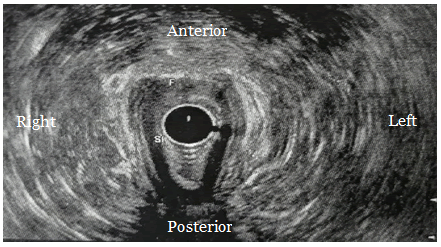
Figure 4: Endoanal ultrasound image showing a posterior defect of IAS and both thinning and scarring of EAS
50% of incontinent patients underwent anorectal manometry
(ARM). Manometric finding were hypotonic sphincter in
91.66% of cases, dyssynergia in 66.66% of cases and loss of voluntary
contractions in 33.33% of cases.
Anorectal suppurations were identified in 35.71% of all cases.
In our study, 23.21% of patients had a CD. Their mean age was
36.30 years (24-76 years), 53.84% men and 41.15% women.
EUS visualized fistulas in 46.15% of cases (Table 1), abscesses in
30.76% and sphincter lesions in 38.46%. EUS guided the drainage of a pelvic abscess, identified in 7.69% cases of perineal CD.
The procedure was performed using a 19-gauge needle.
Table 1: Fistulas identified by EUS in patients with perineal CD.
| Type of fistulas |
Frequency |
| ARVFs fistula |
22.22% |
| Extrasphincteric fistula |
11.11% |
| Transsphincteric fistula |
11.11% |
| Intersphincteric fistula |
11.11% |
| Superficial fistula |
11.11% |
Nonspecific anal fistulas were found in 12.5% of cases (Figure
5). Their mean age was 41.2 years (19-66 years), 57.14% men
and 42.85% women. ARVFs unrelated to CD were objectified in
8.93% of cases. Their mean age was 33.80 years (26-36 years).
80% had a history of obstetrical trauma. EES identified anovaginal
fistulas in 60% of cases and rectovaginal fistulas in 40% of
cases, associated anal sphincters lesions were found in all cases.
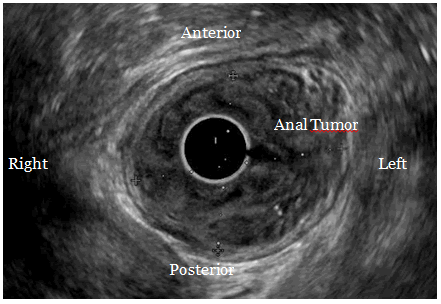
Figure 5: Endoanal ultrasound image showing a low transsphincter fistulas (F) with IAS defect (SI)
Endoanal EUS identified an anal tumor in 1.78% of cases and
allowed the exclusion of an organic cause of terminal constipation
in 3.57% of cases. The anal tumor was visualized in a 76
year old female, presenting with anal pain and bleeding. EES
showed an anal tumor invading the mucosae and submucosae,
with no adjacent lymph nodes involvement and no anal
sphincter complex invasion (Figure 6). There were no abnormal
findings in EUS in 28.57% of cases. The limitations of our study
were the small sample size and the lack of comparison to other
imaging techniques.
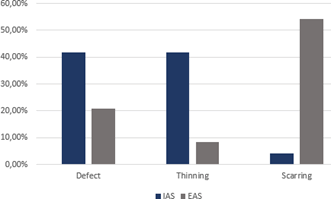
Figure 6: Endoanal ultrasound image showing an anal tumor measuring 39×31mm, invading the mucosae and submucosae
Discussion
Endoanal EUS is a sensitive tool in the evaluation of proctologic
pathologies [1] such as FI, perineal CD, anal fistulas and
abscesses, ARVFs and anal tumors. FI is a highly prevalent problem
that severely impacts a patient’s life [2]. In an American
study, FI was prevalent among women in all age groups, particularly
after the seventh decade followed by the age group
of 55-69 years [3]. In women, obstetrical trauma is the main
cause of anal incontinence, and a history of proctologic surgery
is frequently reported in patients with FI [4]. In our study FI
was prevalent among women, particularly in 40-54 years age
group. 45.83% of patients had a history of perianal surgery and
27.27% of the women were multiparous Endoanal ultrasonography
is considered the gold standard for sphincter evaluation
in FI with most studies revealing 100% sensitivity in identifying
sphincter defects [2]. In our study 42.8% patients presented
with FI and EUS identified IAS defect in 41.66% of these cases,
and EAS defect in 20.83%.
Abscesses and anorectal fistulas are one of the main diseases
diagnosed in adults [5]. In our study, anorectal suppurations
were identified in 35.71% of cases, related to CD in 23.21% and
unrelated to CD in 12.5% of cases. Anal fistulas are common
and typically associated with pain, FI, impaired quality of life
and work incapacity. They occur with more frequently in men
than in women with an average age of 40 years. In 80% of cases,
anal fistulas are cryptogenic: secondary to an infection of
the Hermann and Desfosses anal glands [6]. The results of our
study were in accordance with a mean age of 41.2 years and
anal fistulas occurring more frequently in men. Endoanal EUS
visualizes the detailed anatomy of the fistula and is particularly
well suited for the identification of internal opening. 3D EUS
provides an excellent view of fistula tracts with image reconstructions
in various planes. This helps distinguish between low
transsphincter, high transsphincter, or suprasphincter fistula
tracks [7]. Perianal CD has a variable incidence ranging from
3.8% to 80% [8]. It has been reported that perineal CD is more
frequent in patients with CD younger than 35 years old and that
anal lesions can precede the onset of intestinal symptoms [9].
Anal EUS is one of the key examinations in perianal CD, particularly
in complex and recurrent fistulas as indicated by the
European Crohn’s and Colitis Organization and the American
Gastrointestinal Association guidelines [10]. In our study fistulas
were found in 46.15% cases of perineal CD cases, abscesses
in 30.76% and sphincter lesions in 38.46%. A meta-analysis reported
a sensitivity and specificity for endoanal ultrasound of
0.87 and 0.43 respectively for fistula detection in perianal CD
[11]. Anal EUS can also be used to guide therapy, assess therapeutic
response, and follow patients until resolution of inflammatory
activity of CD [12]. In our study, EUS guided drainage
was performed in a case of perirectal abscess.
ARVFs are relatively rare, accounting for about 5% of all anorectal
fistulas [13]. Obstetric trauma is the most prevalent cause
of trauma related and likely all ARVFs followed by CD [14]. In
our study 28.57% of ARVFs were related to CD and 57.14% to
obstetric trauma. Endoanal EUS particularly contrast enhanced EUS can identify the location and characteristics of the ARVFs
tracks and evaluate internal and external anal sphincters [15].
Anal EUS with anorectal manometry should be performed in all
ARVFs related to obstetric trauma, to assess the integrity of the
anal sphincters [16].
Anal cancer is relatively uncommon, accounting for 2.4% of all
digestive system malignancies. Squamous cell carcinoma is the
most frequent subtype [17].
The median age at diagnosis of anal cancer is approximately 60
years [17] and is more common in women [18]. The most common
symptom at presentation is anorectal bleeding [17]. Endoanal
EUS is a useful technique in anal cancer for evaluating
local tumor invasion and lymph node metastasis and, thereby,
establishing the staging of anal cancer [19]. In our study, anal
EUS allowed the diagnosis and evaluated the extension of an
anal tumor in 1.78% of all cases.
Conclusion
Endoanal EUS is a sensitive technique in the diagnosis of benign
and malignant anal disease, by visualizing anal canal anatomy,
identifying the lesions, evaluating the extension of anal cancer
and helping to determine the need for surgical procedures. In
our study endoanal EUS had a great diagnostic contribution,
was well tolerated and related proctological symptoms to various
anal disorders.
REFERENCES
- Bhatia V, Tajika M, Hijioka S (2019) Radial-scanning flexible EUS of the anorectum and pelvis. Endosc Ultrasound. 8:288-297
[Crossref] [Google Scholar] [PubMed]
- Albuquerque A (2015) Endoanal ultrasonography in fecal incontinence: Current and future perspectives. World J Gastrointest Endosc. 7:575-581
[Crossref]
- Ditah I, Devaki P, Luma HN, Ditah C , Njei B, et al. (2014) Prevalence, trends, and risk factors for fecal incontinence in United States adults, 2005-2010. Clin Gastroenterol Hepatol. 12:636-43
[Crossref] [Google Scholar] [PubMed]
- Saldana Ruiz N, Kaiser AM (2017) Fecal incontinence-Challenges and solutions. World J Gastroenterol.23:11-24.
[Crossref] [Google Scholar] [PubMed]
- Abcarian H (2011) Anorectal infection: Abscess-fistula. Clin Colon Rectal Surg. 24:14- 21
[Crossref] [Google Scholar] [PubMed]
- Dubois A, Carrier G, Pereira B, Gillet B, Faucheron JL, et al. (2015) Therapeutic management of complex anal fistulas by installing a nitinol closure clip: Study protocol of a multicentric randomised controlled trial-FISCLOSE. BMJ Open. 5:009884
[Crossref] [Google Scholar] [PubMed]
- Sharma A, Yada V, Sahu M, Verma A (2020) Current imaging techniques for evaluation of fistula in ano: A review. Egypt J Radiol Nucl Med. 51:130
[Crossref] [Google Scholar] [Research Gate]
- Safar B, Sands D (2007) Perianal Crohn's disease. Clin Colon Rectal Surg. 20:282- 293
[Crossref] [Google Scholar] [PubMed]
- Pescatori M, Interisano A, Basso L (1995) Management of perianal Crohn's disease. Results of a multicenter study in Italy. Dis Colon Rectum. 38:121-4
[Crossref] [Google Scholar] [PubMed]
- Molteni RA, Bonin EA, Baldin JA, Barreto RAY, Brenner AS, et al. (2019) Usefulness of endoscopic ultrasound for perianal fistula in Crohn's disease. Rev Col Bras Cir. 45:1840
[Crossref] [Google Scholar] [PubMed]
- Siddiqui MR, Ashrafian H, Tozer P, Daulatzai N, Burling D, et al. (2012) A diagnostic accuracy meta-analysis of endoanal ultrasound and MRI for perianal fistula assessment. Dis Colon Rectum. 55:576-85
[Crossref] [Google Scholar] [PubMed]
- Schwartz DA, White CM, Wise PE, Herline AJ (2005) Use of endoscopic ultrasound to guide combination medical and surgical therapy for patients with Crohn's perianal fistulas. Inflamm Bowel Dis. 11:727-32
[Crossref] [Google Scholar] [PubMed]
- Gurland BH, Vogel JD (2022) Rectovaginal Fistula. The ASCRS Textbook of Colon and Rectal Surgery. pp 281-291
[Crossref] [Google Scholar] [Research Gate]
- Saclarides TJ (2002) Rectovaginal fistula. Surg Clin North Am. 82:1261-72
[Crossref] [Google Scholar] [PubMed]
- Sudoł-Szopińska I, Jakubowski W, Szczepkowski M (2002) Contrast-enhanced endosonography for the diagnosis of anal and anovaginal fistulas. J Clin Ultrasound. 30:145-50
[Crossref] [Google Scholar] [PubMed]
- Manaouil D, Dumont F, Regimbeau JM, Duval H, Brazier F, et al. (2004) Fistules rectovaginales acquises de l’adulte. Gastroenterol Clin Biol. 28:1267-1279
[Crossref] [Google Scholar] [PubMed]
- Cattelan L, Ghazawi FM, Le M, Savin E, Zubarev A, et al. (2020) Investigating epidemiologic trends and the geographic distribution of patients with anal squamous cell carcinoma throughout Canada. Curr Oncol. 27:294-306
[Crossref] [Google Scholar] [PubMed]
- Babiker HM, Kashyap S, Mehta SR, Lekkala MR, Cagir B (2022) Anal Cancer. StatPearls [Internet], Treasure Island (FL). StatPearls Publishing.
[Google Scholar]
- Kim MJ (2015) Transrectal ultrasonography of anorectal diseases: Advantages and disadvantages. Ultrasonography. 34:19-31
[Crossref] [Google Scholar] [PubMed]
Citation: Idrissi MS, Salihoun M, Serraj I, Acharkim M, Kabbaj N (2022) The Usefulness of Endoanal Endoscopic Ultrasound in Anal Disease. J Clin Gastroenterol Hepatol.6 No.6.27
Copyright: © Idrissi MS, et al. This is an open-access article distributed under the terms of the Creative Commons Attribution License, which permits unrestricted use, distribution, and reproduction in any medium, provided the original author and source are credited.







